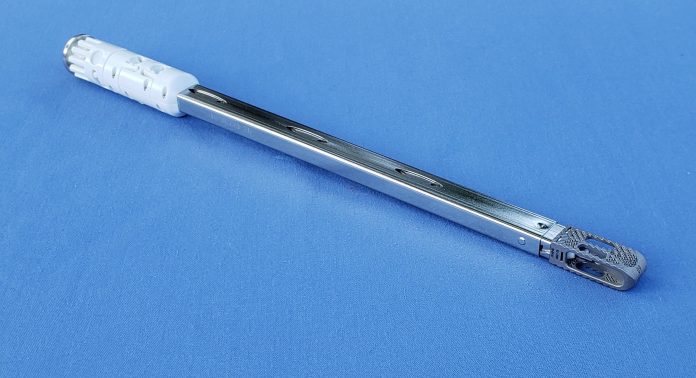What To Know
- Indications for UseThe KG2 implant is indicated for transforaminal and posterior interbody fusion of the spine in skeletally mature patients with degenerative disc disease (DDD) and up to Grade 1 spondylolisthesis of the lumbar spine at one level or two contiguous levels.
- “Getting adequate graft fill volume and distribution of graft within the intervertebral disc space is one of the most vexing challenges in spinal fusion procedures, which led us to develop the unique flow-thru technology in our KG series products,”.
Kleiner Device Labs today announced that it has received U.S. Food and Drug Administration (FDA) 510(k) market clearance for its KG™2 Surge™ flow-thru interbody system.
The company notes the system maximizes total bone graft delivery volume, better distributes graft bilaterally into the intervertebral disc space, and streamlines the implant delivery, positioning, and grafting process for TLIF and PLIF spinal fusion procedures.
“Getting adequate graft fill volume and distribution of graft within the intervertebral disc space is one of the most vexing challenges in spinal fusion procedures, which led us to develop the unique flow-thru technology in our KG series products,” noted Jeff Kleiner, MD, founder and CEO of Kleiner Device Labs. “The new KG2 Surge system integrates graft delivery with the interbody device delivery. It allows the surgeon to first distract the disc space by inserting the implant, and then packing the entire disc space bilaterally through the KG2 Surge implant, using the attached cannulated inserter. Fully packing the graft with the disc space in the distracted and final position ensures graft/endplate contact. The system’s large rectangular cannula allows simplified delivery of a wide range of allograft and autograft products, including viscous and fibrous materials.”
The implant’s unique I-beam architecture and ramp design allow unrestricted flow to bilaterally fill and integrate the implant into the prepared disc space. The KG2 Surge interbody device is 3-D printed titanium and features a diamond lattice porous structure to facilitate bone ingrowth.
The KG2 Surge flow-thru interbody system comes with the interbody device pre-assembled with the cannula in a single-use sterile tray. Added Dr. Kleiner, “The surgeon opens our tray with a ready-to-use system in their hands. The learning curve is low for operating room staff, and the KG2 Surge system works in both MIS and open approaches. The associated reusable instrument package allows for immediate revision at every step, should the surgeon desire implant repositioning or removal.”
KG2 Surge interbody devices will initially be available in footprints of 9x24mm, 11x28mm and 11x32mm, with heights of 7 to 14mm, and lordosis of 0 and 6 degrees.
A short video demonstrating how the KG2 Surge flow-thru interbody system works is available here.
The company will next launch the product with a select group of surgeons and will be building inventory for its full commercial launch.
Indications for Use
The KG2 implant is indicated for transforaminal and posterior interbody fusion of the spine in skeletally mature patients with degenerative disc disease (DDD) and up to Grade 1 spondylolisthesis of the lumbar spine at one level or two contiguous levels. DDD is defined as back pain of discogenic origin with degeneration of the disc confirmed by history and radiographic studies. The KG2 implant is used to facilitate interbody fusion in the lumbar spine from L2 to S1 using autogenous and/or allogenic bone graft comprised of cancellous and/or corticocancellous bone graft to facilitate fusion. The interbody fusion devices are intended to be used with FDA-cleared supplemental fixation designed for the implanted level. Patients should have at least six months of non– operative treatment prior to treatment with an interbody fusion device.
